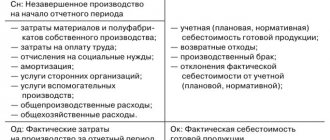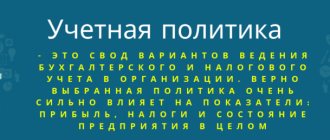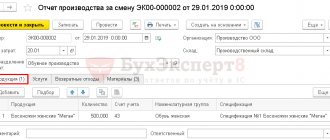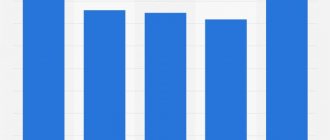Classification of methods for accounting for production costs and calculating costs
To begin with, let’s determine what the correct construction of a cost accounting methodology (hereinafter referred to as CM) can provide, who needs it and why.
The following management KM priorities can be identified:
- checking the correct flow of the production cycle;
- collecting information on costs to analyze them and find ways to optimize them;
- making decisions by management on other cost management issues.
The objects of KM and cost calculation most often differ. The first of these is the basis on which costs are sorted. The object of KM can be the place of its origin, the center of responsibility, the type or group of products, the type of resources. The second is the type of product (work, service), semi-finished products, products at different stages of readiness. To distinguish between the concept of knowledge management and the concept of cost calculation, we propose to consider a diagram.
The sequence of reflecting and calculating costs and costs consists of accounting (steps 1–5) and cost accounting (steps 4–6). These steps are interconnected, and their implementation provides data for cost management. At the moment, the literature on management accounting describes a large number of methods for cost accounting and calculating product costs . A unified generally accepted systematization has not yet been created for them. All these methods were developed to solve various management problems and are often classified according to the following criteria:
1. For UZ objects:
- process-by-process
- transverse,
- custom.
The process-by-process method will be discussed below, and about the process-by-process and order-by-process method, read the articles on our website:
- “Transitional method of cost accounting - essence and features”;
- “Custom method of cost accounting and costing”.
2. In terms of completeness of the ultrasound:
- full cost system
- system of incomplete (partial) costs.
3. In terms of efficiency of KM and control:
- actual cost method,
- standard cost method.
Some methods are losing their relevance due to the failure to provide complete and correct information on costs and costs. An example of this is the boiler method.
Boiler cost accounting method
The development and implementation of cost accounting and product costing methods took place gradually. Initially, costs were taken into account using the boiler method. The main feature of this method is that all costs, regardless of their type, place in which they arose, or other characteristics, are taken into account in a single register throughout the entire period. The result is the total amount of the enterprise’s costs for the period, which cannot be distributed correctly or even close to reality by the types of products manufactured. The cost of a particular type of manufactured product is calculated by distributing all boiler costs relative to some base, for example, the planned cost. As a result, the cost value turns out to be very approximate. Such accounting does not provide data that allows one to control costs, look for ways to optimize them, and solve other management issues. At the moment, the boiler method of cost calculation is also in use, but is rarely used. It is relevant for industries where there is no need for analytical accounting, for example, with a single output product (coal mining industry, small enterprises with a single type of product).
Important features are not only the accounting of production costs, but also the reflection of work in progress in the profit declaration. And for this, it is important to properly organize tax accounting of work in progress and finished products. ConsultantPlus experts tell you in detail how to do this correctly. Get free demo access to K+ and go to the Ready Solution to find out all the details of this procedure.
The main regulatory documents used when accounting for production costs are:1. Regulations on accounting and reporting in the Russian Federation (approved by order of the Ministry of Finance of the Russian Federation dated December 26, 1994 No. 170).
2. Chart of accounts for accounting of financial and economic activities of enterprises and Instructions for its application (approved by order of the Ministry of Finance of the USSR dated November 1, 1991 No. 56 and recommended for use on the territory of the Russian Federation by letter of the Ministry of Economy and Finance of the RSFSR dated December 19, 1991 No. 185 ; as amended by orders of the Ministry of Finance of the Russian Federation dated December 28, 1994 No. 173 and July 28, 1995 No. 81).
3. Regulations on the composition of costs for the production and sale of products (works, services), included in the cost of products (works, services), and on the procedure for generating financial results taken into account when taxing profits (approved by Decree of the Government of the Russian Federation dated August 5, 1992 No. 552; with amendments and additions approved by the Government of the Russian Federation dated July 1, 1995 No. 661 and November 20, 1995 No. 1133).
4. Basic provisions for planning, accounting and calculating the cost of production at industrial enterprises (approved by the State Planning Committee of the USSR, the Ministry of Finance of the USSR, the State Committee for Prices of the USSR, the Central Statistical Office of the USSR on July 20, 1970).
5. Standard methodological recommendations for planning and accounting for the cost of construction work (approved by the State Construction Committee of the Russian Federation on November 30, 1993 No. 714/187 in agreement with the Ministry of Economy of the Russian Federation and the Ministry of Finance of the Russian Federation; sent to financial authorities by the Ministry of Finance of the Russian Federation dated December 30, 1993 No. 161).
6. Industry guidelines (instructions) for planning, accounting and calculating the cost of products (works, services).
7. Methodological recommendations for planning, accounting and calculating the cost of products (works, services) in agriculture (approved by the Ministry of Agriculture of the Russian Federation on March 11, 1993 No. 211/473).
8. Features of the composition of costs by industry sector approved by the relevant ministries and departments and agreed with the Ministry of Finance and the Ministry of Economy of the Russian Federation.
9. Methodological recommendations for accounting of costs included in distribution and production costs, and financial results at trade and public catering enterprises (approved by order of the Committee of the Russian Federation on Trade of April 20, 1995 No. 155/322).
10. “On amendments to the letter of the Ministry [of Finance of the Russian Federation dated August 8, 1994 No. 103 “On clarifying the norms of expenses for receiving and servicing foreign delegations and individuals.” Letter of the Ministry [of Finance of the Russian Federation dated October 27, 1995 No. 118.
11. “On amendments to the letter of the Ministry of Finance of the Russian Federation dated July 27, 1992 No. 61 “On changing the norms for reimbursement of travel expenses taking into account changes in the price index.” Letter of the Ministry of Finance of the Russian Federation dated October 27, 1995 No. 117.
12. “On the standards for reimbursement of expenses for short-term business trips.” Letter of the Ministry of Finance of the Russian Federation dated April 26, 1993 No. 52 “On amendments to the letter of the Ministry of Finance of the Russian Federation dated October 6, 1992 No. 94 “Norms and standards for entertainment expenses, advertising expenses and training and retraining of personnel on a contractual basis” basis with educational institutions, regulating the amount of attribution of these expenses to the cost of products (works, services), and the procedure for their application.” Letter of the Ministry of Finance of the Russian Federation dated April 29, 1994 No. 56.
13. “On standard forms of quarterly financial statements and instructions for their completion in 1995.” Order of the Ministry (of Finance of the Russian Federation dated December 20, 1994 No. 168.
14. “On the annual financial statements of organizations for 1995.” Order of the Ministry of Finance of the Russian Federation dated October 19, 1995 No. 115. Appendices 1, 2, 3 to the order of the Ministry (Finance of the Russian Federation dated October 19, 1995 No. 115.
15. “On the procedure for calculating and paying value added tax.” Instruction of the State Tax Service of the Russian Federation dated October 11, 1995. No. 39.
16. “On the procedure for calculating and paying income tax for enterprises and organizations to the budget.” Instruction of the State Tax Service of the Russian Federation dated August 10, 1995 No. 37.
The organization of accounting for production costs is based on the following principles: the invariability of the adopted methodology for accounting for production costs and calculating the cost of production throughout the year; completeness of recording of all business transactions; correct attribution of expenses and income to reporting periods; differentiation in accounting for current production costs and capital investments; regulation of the composition of product costs.
One of the main conditions for obtaining reliable information about the cost of production is a clear definition of the composition of production costs.
In our country, the composition of production costs is regulated by the state. The basic principles of the formation of this composition are defined in the Law of the Russian Federation “On the income tax of enterprises and organizations” and are specified in the Regulations on the composition of costs with amendments and additions made to this Regulation, which clearly define the costs attributable to the cost of products (works, services) and expenses , produced at the expense of relevant sources of financing (profits of the organization, special-purpose funds, targeted financing and targeted revenues, etc.).
The regulatory role of the state in relation to the cost of production is also manifested in the establishment of depreciation standards for fixed assets, tariffs for contributions to social needs, to some types of road funds, etc.
Based on the Regulations on the composition of costs, ministries, departments, intersectoral state associations, concerns, etc. develop industry regulations on the composition of costs and methodological recommendations on planning, accounting and calculating the cost of products (works, services) for subordinate enterprises. It should be noted that the changes and additions made to the Regulations on the composition of costs by the Government of the Russian Federation on July 1, 1995, determined new approaches of the state to the formation of product costs. Until July 1, 1995, many expenses were included in the cost of production within the limits established by the state (travel expenses, advertising expenses, entertainment expenses, etc.), and the excess of these expenses was attributed to a decrease in the net profit of organizations. As a result of this approach, organizations did not have real cost indicators, which made cost management difficult.
Since July 1, 1995, expenses normalized by the state are included in the cost of production in the amount of actual expenses, and the adjustment of these costs, taking into account the limits, norms and standards approved in the established manner, is carried out for tax purposes. Changing the state's approaches to the formation of product costs now allows organizations to calculate real indicators of the cost of products (works, services),
For the organization of accounting of production costs, the choice of the nomenclature of synthetic and analytical production accounts and calculation objects is of great importance.
In large and medium-sized organizations, to account for the costs of production, accounts 20 “Main production”, 23 “Auxiliary production”, collector-distribution accounts are used: 25 “General production expenses”, 26 “General expenses”, 28 “Losses from defects”, 31 “Expenses future periods", 36 "Completed stages of work in progress", 37 "Product output (work, Main production" and 23 "Auxiliary production" write off the actual cost of manufactured products (work, services). The balance of these accounts characterizes the amount of costs for work in progress.
In small organizations, to account for production costs, as a rule, they use accounts 20 “Main production”, 26 “General business expenses”, 31 “Deferred expenses” or only account 20.
The new chart of accounts does not provide for the use of account 24 “Expenses for the maintenance and operation of machinery and equipment.” The costs recorded in this account are reflected in account 25 “General production expenses” in the new chart of accounts.
The new chart of accounts additionally introduced accounts 36 “Completed items for work in progress” and 37 “Output of products (works, services)”.
Account 36 is advisable to use in organizations carrying out long-term work (construction, design, etc.), in which payments are made not as a whole for completed and delivered work, but for individual stages of work. Account 37 is used as necessary and is intended to account for completed products (works, services) and identify deviations [of the actual production cost of products (works, services) from the standard or planned cost. The use of this account allows you to eliminate labor-intensive calculations to determine deviations of the actual cost from the planned cost for finished, shipped and sold products.
Below are the main business transactions in the production cost accounts and show the procedure for reflecting business transactions in the accounting accounts.
Business transactions for the month in rubles.
1. Materials released 600,000
Including:
for production of products 500,000
for shop needs 50,000
for general economic needs 40,000
for packaging and packaging of products 10,000
2. Accrued wages 100,000
Including:
workers of main production 80,000
workshop personnel 10,000
plant management personnel 8,000
employees selling products 2,000
3. Accrued to the social insurance fund, 40,000
Pension Fund, State Employment Fund
population and compulsory health insurance funds
4. Accrued depreciation on fixed assets 60,000
Including:
for fixed assets of workshops 40,000
for plant management fixed assets 20,000
5. General production expenses written off 104,000
6. General business expenses written off 71200
7. Capitalized finished products at actual cost 687,200
8. Products were shipped to the buyer in the amount of 1,000,000
9. Payments received for sold products 1,000,000
10. Actual cost of shipped products written off 687,200
11. Business expenses written off 12800
12. The financial result of product sales was written off 300,000
Costing objects are individual products, groups of products, semi-finished products, works and services, the cost of which is determined. Analytical accounting of production costs is carried out, as a rule, according to costing objects. It is allowed to open analytical accounts not for each object, but for their group.
For each object, it is necessary to choose the correct calculation unit, which are mainly used natural (tons, meters, etc.) and conventional natural units, calculated using coefficients (a thousand conventional cans of canned food, etc.). The calculation units may not coincide with the natural accounting unit. In processing organizations, for example, the accounting unit is 1 kg of product, and the costing unit is 1 ton or 1 c. The use of enlarged costing units simplifies the preparation of planned and reporting cost estimates.
Standard method of cost accounting and cost calculation
The essence of the standard accounting method is the previous calculation of standard costs for selected objects, as well as the incidental determination of deviations of actual costs from standard ones in the production process. For each type of product, a standard cost estimate is compiled, which indicates the norms for the consumption of materials, wages and other items. Accounting is carried out in such a way that it is possible to divide current costs into standard and deviations. Deviation data allows you to find the reasons for non-compliance with standards, find the culprits or shortcomings in the technological process.
In accounting, costs are also reflected according to norms and deviations, usually using account 40. The diagram shows the principle of accounting according to norms. The actual cost is written off to the debit of account 40 from the UZ accounts for production, and the standard cost is reflected as a credit in correspondence with accounts 43, 90. When saving, a reversal entry is made Dt 90 Kt 40, and in case of overexpenditure, an additional entry is made Dt 90 Kt 40 for the amount of deviations.
Direct and indirect costs in accounting
Of all the costs of manufacturing a product, its cost is added up. Account 20 contains almost all production costs that can be classified as direct. The main production account on debit corresponds with accounts 02, 10, 23, 25, 26, 60, 69, 70 on credit. To determine the cost of a product of a certain type, open analytical accounts for individual types of products and costs for account 20. This will simplify the procedure for generating cost by type.
Indirect costs are contained in accounts 25 and 26. To prepare loan entries, the same correspondence is used as for direct costs. Do not forget that indirect costs cannot be attributed directly to the cost of one product. Select a reasonable allocation basis and note your choice in the accounting policy.
Results
To effectively use cost accounting methods and calculate product costs, an organization must analyze its processes in detail, identify current management tasks, identify KM objects, and ultimately select one or more methods.
The labor-intensive methods of cost accounting and calculating product costs are compensated by obtaining detailed information that helps in solving pressing issues. You can find more complete information on the topic in ConsultantPlus. Free trial access to the system for 2 days.







